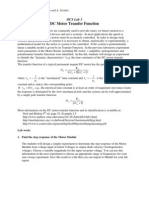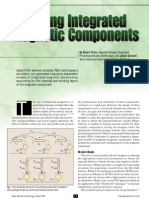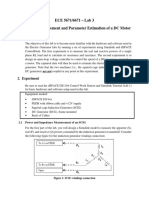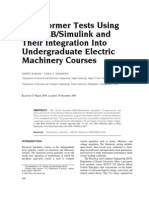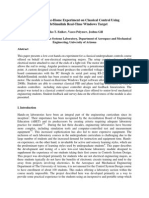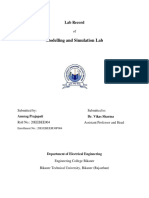0 ratings0% found this document useful (0 votes)
83 viewsFall 2011 Lab332a8
instructor name
Date Submitted:
Uploaded by
Allen 艾倫 EgarCopyright
© © All Rights Reserved
Available Formats
Download as PDF, TXT or read online on Scribd
0 ratings0% found this document useful (0 votes)
83 viewsFall 2011 Lab332a8
instructor name
Date Submitted:
Uploaded by
Allen 艾倫 EgarCopyright
© © All Rights Reserved
Available Formats
Download as PDF, TXT or read online on Scribd
You are on page 1/ 4
ET 332a
Laboratory Activities and Experiments
1.)
Using Spreadsheets and MathCAD in Laboratory Calculations
(Handouts)
The Excel spreadsheet is introduced and used to produce graphs that are
commonly found in technical reports. Linear graphs are produced. Semi-log
plots are created by using a log function to reduce the range of the data and by
using the scaling abilities of the spreadsheet. Embedding the results into reports
is also demonstrated. Online video is available for reference. The Microsoft
Equation Editor is demonstrated. An online video is available for further
reference. MathCAD software combines graphics, text editing, and calculation
functions into an integrated package. A tutorial document and online software
demonstrations explain how to perform basic calculations found in electrical
measurement. A student activity uses the developed skills to make plots and
produce professional solutions to technical problems.
2.)
Power Laboratory Safety and Work Procedures/Resistance of DC machines
(Hampden Experiment 1)
Students are instructed in high voltage laboratory safety rules. Avoiding electric
shock and other safety hazards encountered in the power lab are covered. The
basic operation of the fractional-horsepower motor lab equipment will be covered
The class will perform a simple experiment to determine the dc resistance of the
field and armature coils of a typical dc motor.
3.)
Saturation Curve of a Generator
(Hampden Experiment 2)
The main object of this lab is to obtain the necessary data to plot a saturation
curve of a separately excited dc generator. The shape of this curve is a scaled
representation of a machines B-H curve. The effects of saturation on the
output of a generator are observed.
4.)
Counter EMF Force
(Hampden Experiment 16)
The counter EMF force of a dc machine will be observed. The laws of induction
and force on a conductor will be verified using a dc machine.
5.)
Load Characteristics of a Separately-Excited Shunt Generator
(Hampden Experiment 6)
The load level Vs terminal voltage characteristic of a separately-excited shunt
generator is developed. The voltage output capabilities of the machine are
examined at the rated speed and field current of the device.
Fall 2011
lab332a8.doc
6.)
Shunt Motor Characteristics
(Hampden Experiment 18)
The speed-torque characteristic of the shunt dc motor is determined
experimentally. The speed regulation of the machine will be found. The
relationship between the load torque and the armature current is examined.
7.)
Efficiency and Losses in a Dc Shunt Motor
(Hampden Experiment 21)
The operating efficiency of a shunt dc machine will be determined by lab tests.
The sources of losses in dc machines are identified and measured. These
losses can be divided into fixed and load-variable components.
8.)
Series Motor Characteristics
(Hampden Experiment 19)
The speed-torque characteristic of the series dc motor is determined
experimentally. The speed regulation of the machine will be found. The
relationship between the load torque and the armature current is examined.
9.)
Compound Motor Characteristics
(Hampden Experiment 20)
The speed-torque characteristic of the compound dc motor is determined
experimentally. The speed regulation of the machine will be found. The
relationship between the load torque and the armature current is examined.
10.)
Shunt Generator Output Polarity and Voltage Build-up
(Hampden Experiment 3)
This experiment covers the correct procedures for preparing a shunt generator to
for operation. The voltage build-up process is examined. The proper
connections for voltage build-up are given.
11.)
Field Resistance Vs Generator Voltage Build-up/Motor Control Simulator
(Hampden Experiment 4)
This lab examines the affects of field resistance on generator voltage build-up.
The lab demonstrates the effect of excessive field resistance on terminal voltage.
The second section introduces ladder diagrams and motor control with an
animated, computer-based simulator.
12.)
Tour of SIUC Physical Plant PV array
The class will tour the SIUC physical plant 30 kW PV array. Representatives of
the physical plant will explain the operation of the array. The plant personnel will
give an overview of the interface and control circuits. They will also discuss
economic considerations of solar power under existing technologies.
Fall 2011
lab332a8.doc
2
Lab Reporting Format
The laboratory procedure will be handed out approximately a week before it will be
performed. Reading the lab prior to lab makes the performance of the experiment more
efficient. All data collected in lab must be initialed and dated by the lab instructor. All
reports submitted without instructor verification will receive a zero.
The experiments for this course will be reported in an abbreviated format. The
laboratory handout has an experiment objective and procedure included. There is no
need to restate these sections in another report. To fully document the results of the
experiment, all questions, problems and graphs required by the laboratory handout
must be completed. Also, a discussion of the topics covered in the experiment and how
they relate to the lecture material should be completed. This discussion should be at
least one page type written and double-spaced.
The report should have the following sections:
1.) Cover page that is like the one attached to this document
2.) All the pages from the laboratory handout that have questions, problems,
tables, graphs.
3.) Discussion
It is permissible to answer the questions/problems on a separate sheet, but the
questions and problems must be numbered and all the answers typed. Some of the lab
handouts have places to make graph in them. It is also permissible make graphs using
software packages such as Excel instead of using this page. If a graph is made on a
separate sheet it must have:
1.) A title
2.) Labels on each axis
3.) Units on each axis
4.) A legend if more than on curve is on the same axis. This identifies each
curve on the graph.
The graphs should be scaled to show the data in the most meaningful way. Change the
graph limits so the curve covers most of the axis.
1.)
2.)
3.)
4.)
Hints for Good Reports
Follow the format. If you are not sure about how something should be done, ask
the lab or lecture instructor.
Use computer tools whenever possible. (word processors, drawing tools
spreadsheets) If you have never had any experience with some of these tools or
have a question about how to perform a function using the common software
tools ask the lab or lecture instructor.
Spell-check the document.
Proof-read the document at least once.
Fall 2011
lab332a8.doc
3
Southern Illinois University at Carbondale
Department of Technology
ET 332a
Dc Motors, Generators and Energy Conversion Devices
Experiment #
Experiment Title
Reported by: your name here
Performed By: student name 1
student name 2
student name 3
Date Performed:
You might also like
- Practical Guides to Testing and Commissioning of Mechanical, Electrical and Plumbing (Mep) InstallationsFrom EverandPractical Guides to Testing and Commissioning of Mechanical, Electrical and Plumbing (Mep) Installations4/5 (4)
- Introduction to the simulation of power plants for EBSILON®Professional Version 15From EverandIntroduction to the simulation of power plants for EBSILON®Professional Version 15No ratings yet
- Power Systems Laboratory User Manual: Revised: July 22, 2008No ratings yetPower Systems Laboratory User Manual: Revised: July 22, 200840 pages
- Ee 404 Electrical Machines 1 Lab 3 and 4No ratings yetEe 404 Electrical Machines 1 Lab 3 and 41 page
- Effects of Voltage Sag Due To Starting of Induction Motor-Ed2No ratings yetEffects of Voltage Sag Due To Starting of Induction Motor-Ed214 pages
- Design Project: (Due: Friday, December 8, 2006, 5pm PT)No ratings yetDesign Project: (Due: Friday, December 8, 2006, 5pm PT)6 pages
- Electrical Drive Modeling Through A Multiphysics System Simulation ApproachNo ratings yetElectrical Drive Modeling Through A Multiphysics System Simulation Approach34 pages
- By Robert Prieto, Associate Professor, Universidad: Power Electronics Technology March 2005No ratings yetBy Robert Prieto, Associate Professor, Universidad: Power Electronics Technology March 20055 pages
- Simulation of Impulse Voltagemulink Generator and Impulse Testing of Insulator SimulinkNo ratings yetSimulation of Impulse Voltagemulink Generator and Impulse Testing of Insulator Simulink8 pages
- Session 11b6 Teaching Electric Power Systems Analysis Using Visually Attractive ToolsNo ratings yetSession 11b6 Teaching Electric Power Systems Analysis Using Visually Attractive Tools4 pages
- EE 2301 Circuit Analysis I: Laboratory ManualNo ratings yetEE 2301 Circuit Analysis I: Laboratory Manual85 pages
- I V T ' T M P T T: Electronic Devices and Circuits (MCT-122)No ratings yetI V T ' T M P T T: Electronic Devices and Circuits (MCT-122)6 pages
- I V T ' T M P T T: Electronic Devices and Circuits (MCT-122)No ratings yetI V T ' T M P T T: Electronic Devices and Circuits (MCT-122)6 pages
- Experiment Number Title: Course Title Course Name Instructor: Instructor's NameNo ratings yetExperiment Number Title: Course Title Course Name Instructor: Instructor's Name9 pages
- Simulation of Some Power System, Control System and Power Electronics Case Studies Using Matlab and PowerWorld SimulatorFrom EverandSimulation of Some Power System, Control System and Power Electronics Case Studies Using Matlab and PowerWorld SimulatorNo ratings yet
- Schaum's Outline of Electronic Devices and Circuits, Second EditionFrom EverandSchaum's Outline of Electronic Devices and Circuits, Second Edition5/5 (6)
- Quick Review Outline - Masschusetts Testing for Educator Licensure (MTEL) Tech and Eng ExamFrom EverandQuick Review Outline - Masschusetts Testing for Educator Licensure (MTEL) Tech and Eng ExamNo ratings yet
- Electrical Machines: Lecture Notes for Electrical Machines CourseFrom EverandElectrical Machines: Lecture Notes for Electrical Machines CourseNo ratings yet
- 16.5.1 Packet Tracer Secure Network Devices IZtNo ratings yet16.5.1 Packet Tracer Secure Network Devices IZt2 pages
- Cryptography Data Encryption: Bhaskar Kakulavarapu ISACA-Detroit ChapterNo ratings yetCryptography Data Encryption: Bhaskar Kakulavarapu ISACA-Detroit Chapter33 pages
- 5G PPP 5G Architecture White Paper FinalNo ratings yet5G PPP 5G Architecture White Paper Final182 pages
- Revit Architecture 2008 Read This First For Download: Before You InstallNo ratings yetRevit Architecture 2008 Read This First For Download: Before You Install3 pages
- Online Class Guidelines A. For The Students 1. Technology AccessNo ratings yetOnline Class Guidelines A. For The Students 1. Technology Access2 pages
- Nubee'S Newbie Guide For Fcom: Last Revised July 16, 2016No ratings yetNubee'S Newbie Guide For Fcom: Last Revised July 16, 201610 pages
- Basic Design KCGP-BD-E-IN-RE-0003 Kazakhstan-China Gas Pipeline Project Telecommunication & SCADA Revision 0No ratings yetBasic Design KCGP-BD-E-IN-RE-0003 Kazakhstan-China Gas Pipeline Project Telecommunication & SCADA Revision 012 pages
- CRYPTOGRAPHY AND NETWORK SECURITY PPT by MeNo ratings yetCRYPTOGRAPHY AND NETWORK SECURITY PPT by Me35 pages
- APznzaY78tnl5Y oAf9eS5TdgeXPDlOW4T AmtqiY4PHThk2ZQBAlN TYg2qIhzN8is6Cyb37XgnGHte3fIwNnW5MPM2BaSySYl4QXhx fXWWBjZlqfyJgJNo ratings yetAPznzaY78tnl5Y oAf9eS5TdgeXPDlOW4T AmtqiY4PHThk2ZQBAlN TYg2qIhzN8is6Cyb37XgnGHte3fIwNnW5MPM2BaSySYl4QXhx fXWWBjZlqfyJgJ97 pages
- Practical Guides to Testing and Commissioning of Mechanical, Electrical and Plumbing (Mep) InstallationsFrom EverandPractical Guides to Testing and Commissioning of Mechanical, Electrical and Plumbing (Mep) Installations
- Introduction to the simulation of power plants for EBSILON®Professional Version 15From EverandIntroduction to the simulation of power plants for EBSILON®Professional Version 15
- Power Systems Laboratory User Manual: Revised: July 22, 2008Power Systems Laboratory User Manual: Revised: July 22, 2008
- Effects of Voltage Sag Due To Starting of Induction Motor-Ed2Effects of Voltage Sag Due To Starting of Induction Motor-Ed2
- Design Project: (Due: Friday, December 8, 2006, 5pm PT)Design Project: (Due: Friday, December 8, 2006, 5pm PT)
- Electrical Drive Modeling Through A Multiphysics System Simulation ApproachElectrical Drive Modeling Through A Multiphysics System Simulation Approach
- By Robert Prieto, Associate Professor, Universidad: Power Electronics Technology March 2005By Robert Prieto, Associate Professor, Universidad: Power Electronics Technology March 2005
- Simulation of Impulse Voltagemulink Generator and Impulse Testing of Insulator SimulinkSimulation of Impulse Voltagemulink Generator and Impulse Testing of Insulator Simulink
- Session 11b6 Teaching Electric Power Systems Analysis Using Visually Attractive ToolsSession 11b6 Teaching Electric Power Systems Analysis Using Visually Attractive Tools
- I V T ' T M P T T: Electronic Devices and Circuits (MCT-122)I V T ' T M P T T: Electronic Devices and Circuits (MCT-122)
- I V T ' T M P T T: Electronic Devices and Circuits (MCT-122)I V T ' T M P T T: Electronic Devices and Circuits (MCT-122)
- Experiment Number Title: Course Title Course Name Instructor: Instructor's NameExperiment Number Title: Course Title Course Name Instructor: Instructor's Name
- Simulation of Some Power System, Control System and Power Electronics Case Studies Using Matlab and PowerWorld SimulatorFrom EverandSimulation of Some Power System, Control System and Power Electronics Case Studies Using Matlab and PowerWorld Simulator
- Computer Methods in Power Systems Analysis with MATLABFrom EverandComputer Methods in Power Systems Analysis with MATLAB
- Schaum's Outline of Electronic Devices and Circuits, Second EditionFrom EverandSchaum's Outline of Electronic Devices and Circuits, Second Edition
- Analog Dialogue, Volume 47, Number 1: Analog Dialogue, #9From EverandAnalog Dialogue, Volume 47, Number 1: Analog Dialogue, #9
- Modeling and Dimensioning of Structures: An IntroductionFrom EverandModeling and Dimensioning of Structures: An Introduction
- Analysis of Electric Machinery and Drive SystemsFrom EverandAnalysis of Electric Machinery and Drive Systems
- Computer Aided Design of Electrical MachinesFrom EverandComputer Aided Design of Electrical Machines
- Quick Review Outline - Masschusetts Testing for Educator Licensure (MTEL) Tech and Eng ExamFrom EverandQuick Review Outline - Masschusetts Testing for Educator Licensure (MTEL) Tech and Eng Exam
- Electrical Machines: Lecture Notes for Electrical Machines CourseFrom EverandElectrical Machines: Lecture Notes for Electrical Machines Course
- Cryptography Data Encryption: Bhaskar Kakulavarapu ISACA-Detroit ChapterCryptography Data Encryption: Bhaskar Kakulavarapu ISACA-Detroit Chapter
- Revit Architecture 2008 Read This First For Download: Before You InstallRevit Architecture 2008 Read This First For Download: Before You Install
- Online Class Guidelines A. For The Students 1. Technology AccessOnline Class Guidelines A. For The Students 1. Technology Access
- Nubee'S Newbie Guide For Fcom: Last Revised July 16, 2016Nubee'S Newbie Guide For Fcom: Last Revised July 16, 2016
- Basic Design KCGP-BD-E-IN-RE-0003 Kazakhstan-China Gas Pipeline Project Telecommunication & SCADA Revision 0Basic Design KCGP-BD-E-IN-RE-0003 Kazakhstan-China Gas Pipeline Project Telecommunication & SCADA Revision 0
- APznzaY78tnl5Y oAf9eS5TdgeXPDlOW4T AmtqiY4PHThk2ZQBAlN TYg2qIhzN8is6Cyb37XgnGHte3fIwNnW5MPM2BaSySYl4QXhx fXWWBjZlqfyJgJAPznzaY78tnl5Y oAf9eS5TdgeXPDlOW4T AmtqiY4PHThk2ZQBAlN TYg2qIhzN8is6Cyb37XgnGHte3fIwNnW5MPM2BaSySYl4QXhx fXWWBjZlqfyJgJ




